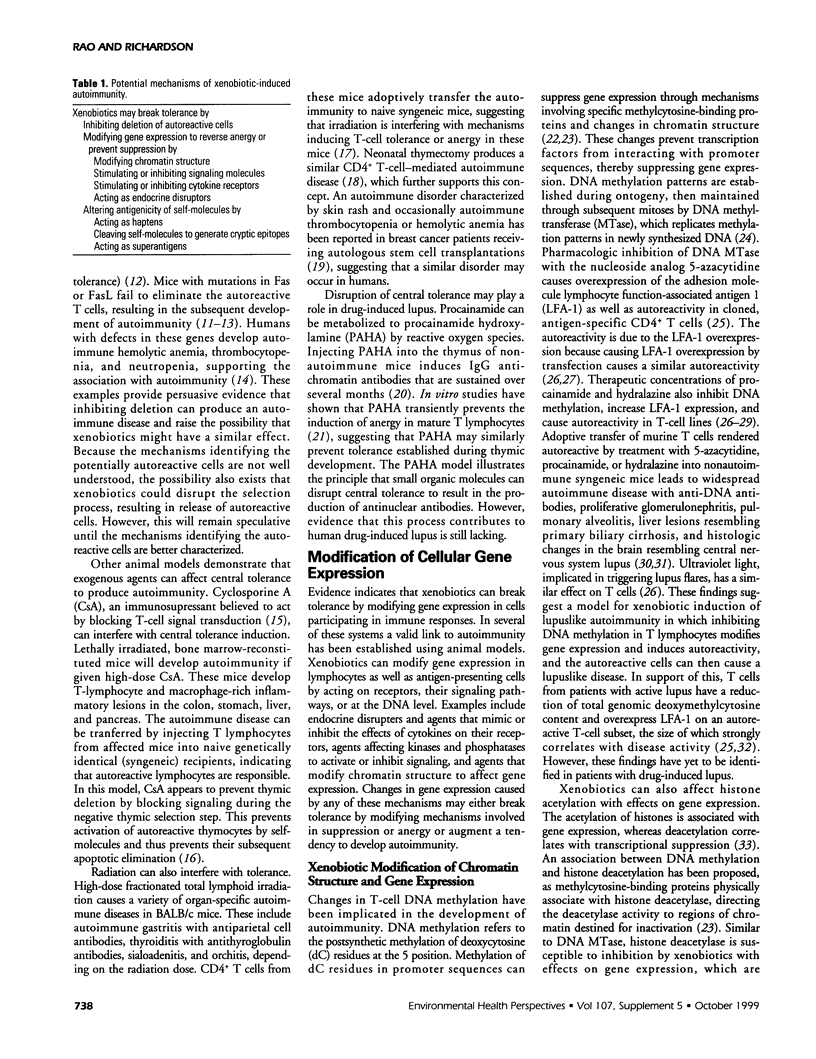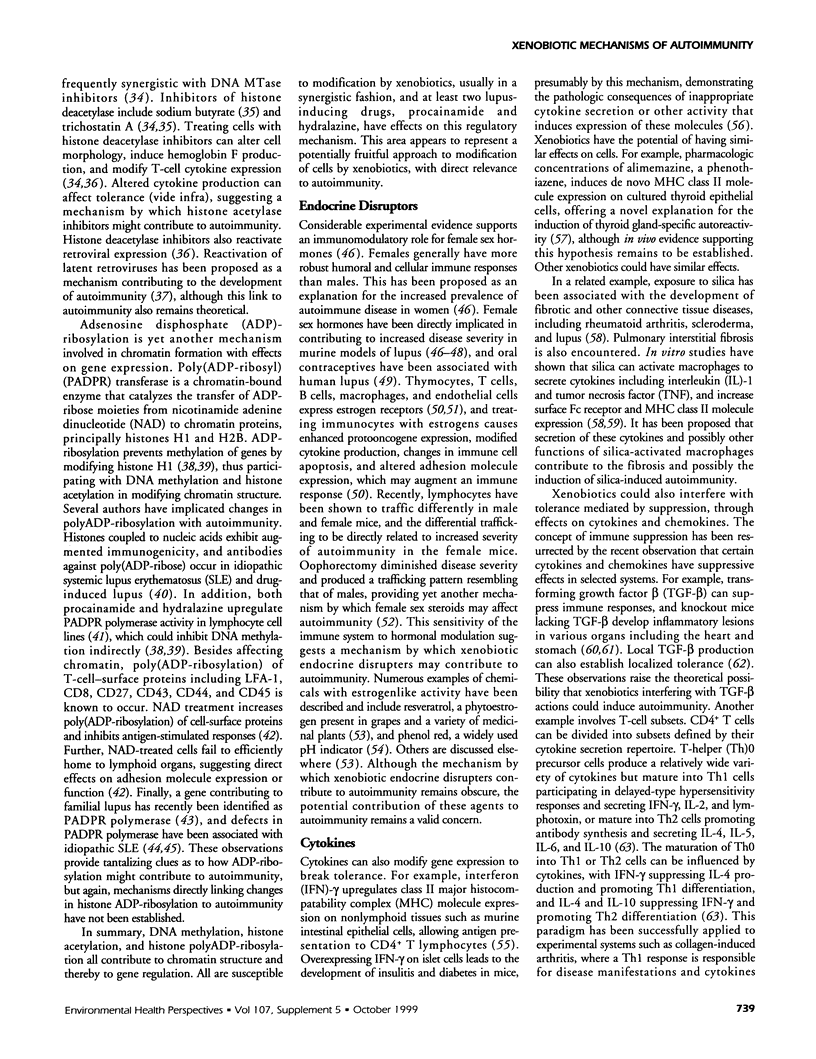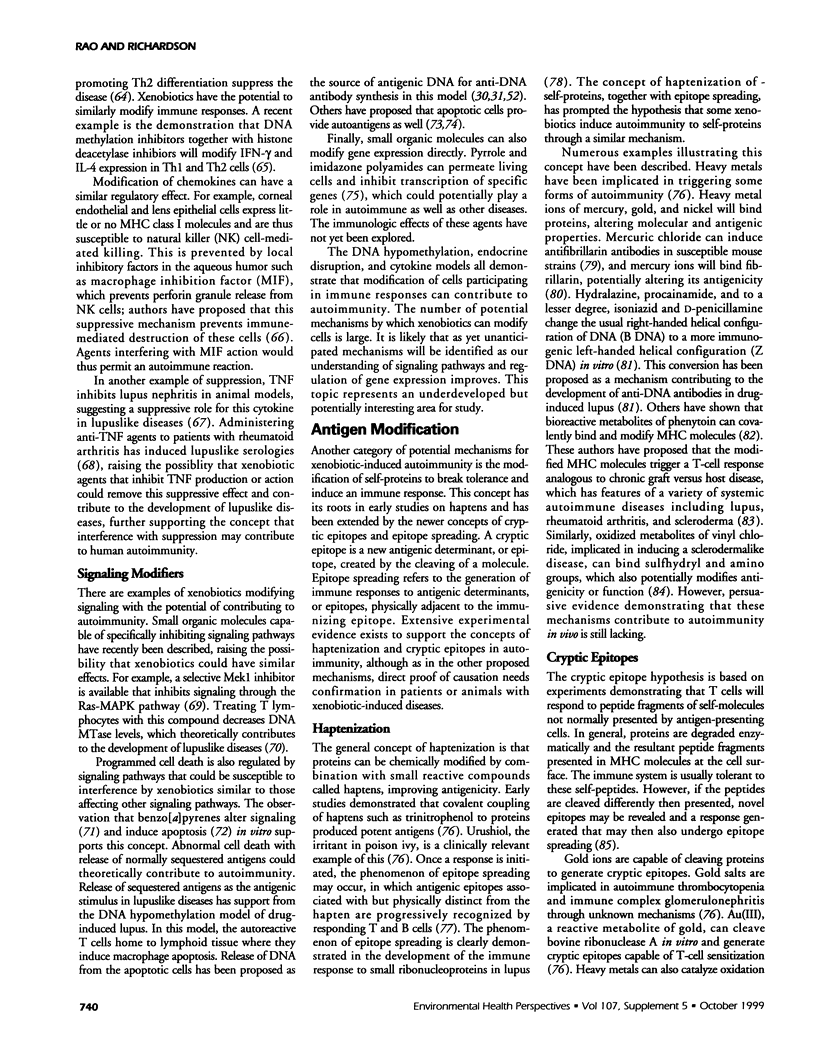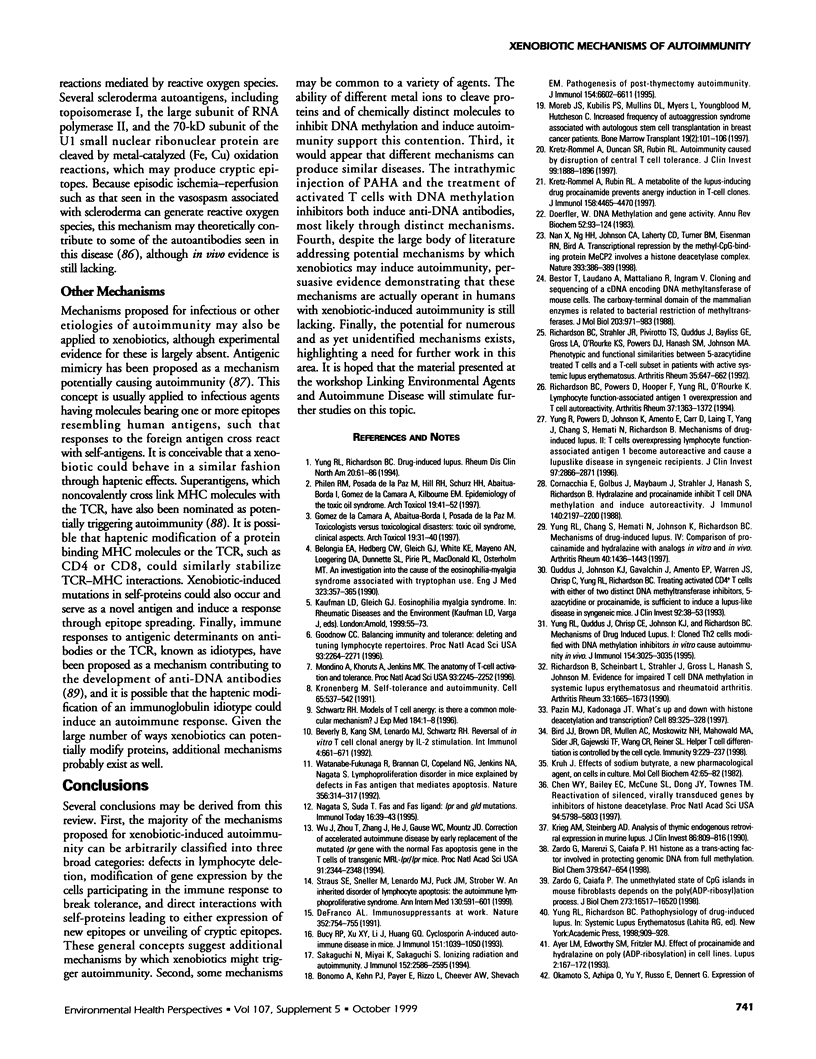Abstract
Environmental and other xenobiotic agents can cause autoimmunity. Examples include drug-induced lupus, toxic oil syndrome, and contaminated l-tryptophan ingestion. Numerous mechanisms, based on (italic)in vitro(/italic) evidence and animal models, have been proposed to explain how xenobiotics induce or accelerate autoimmunity. The majority of these can be divided into three general categories. The first is those inhibiting the processes involved in establishing tolerance by deletion. Inhibiting deletion can result in the release of newly generated autoreactive cells into the periphery. The second mechanism is the modification of gene expression in the cells participating in the immune response, permitting lymphocytes to respond to signals normally insufficient to initiate a response or allowing the antigen-presenting cells to abnormally stimulate a response. Abnormal gene expression can thus disrupt tolerance maintained by suppression or anergy, permitting activation of autoreactive cells. The third is the modification of self-molecules such that they are recognized by the immune system as foreign. Examples illustrating these concepts are presented, and related mechanisms that have the potential to similarly affect the immune system are noted. Some mechanisms appear to be common to a variety of agents, and different mechanisms appear to produce similar diseases. However, evidence that any of these mechanisms are actually responsible for xenobiotic-induced human autoimmune disease is still largely lacking, and the potential for numerous and as yet unidentified mechanisms also exists.
Full text
PDF





Selected References
These references are in PubMed. This may not be the complete list of references from this article.
- Alessi D. R., Cuenda A., Cohen P., Dudley D. T., Saltiel A. R. PD 098059 is a specific inhibitor of the activation of mitogen-activated protein kinase kinase in vitro and in vivo. J Biol Chem. 1995 Nov 17;270(46):27489–27494. doi: 10.1074/jbc.270.46.27489. [DOI] [PubMed] [Google Scholar]
- Ansar Ahmed S., Dauphinee M. J., Talal N. Effects of short-term administration of sex hormones on normal and autoimmune mice. J Immunol. 1985 Jan;134(1):204–210. [PubMed] [Google Scholar]
- Apte R. S., Sinha D., Mayhew E., Wistow G. J., Niederkorn J. Y. Cutting edge: role of macrophage migration inhibitory factor in inhibiting NK cell activity and preserving immune privilege. J Immunol. 1998 Jun 15;160(12):5693–5696. [PubMed] [Google Scholar]
- Ayer L. M., Edworthy S. M., Fritzler M. J. Effect of procainamide and hydralazine on poly (ADP-ribosylation) in cell lines. Lupus. 1993 Jun;2(3):167–172. doi: 10.1177/096120339300200307. [DOI] [PubMed] [Google Scholar]
- Belongia E. A., Hedberg C. W., Gleich G. J., White K. E., Mayeno A. N., Loegering D. A., Dunnette S. L., Pirie P. L., MacDonald K. L., Osterholm M. T. An investigation of the cause of the eosinophilia-myalgia syndrome associated with tryptophan use. N Engl J Med. 1990 Aug 9;323(6):357–365. doi: 10.1056/NEJM199008093230601. [DOI] [PubMed] [Google Scholar]
- Bestor T., Laudano A., Mattaliano R., Ingram V. Cloning and sequencing of a cDNA encoding DNA methyltransferase of mouse cells. The carboxyl-terminal domain of the mammalian enzymes is related to bacterial restriction methyltransferases. J Mol Biol. 1988 Oct 20;203(4):971–983. doi: 10.1016/0022-2836(88)90122-2. [DOI] [PubMed] [Google Scholar]
- Beverly B., Kang S. M., Lenardo M. J., Schwartz R. H. Reversal of in vitro T cell clonal anergy by IL-2 stimulation. Int Immunol. 1992 Jun;4(6):661–671. doi: 10.1093/intimm/4.6.661. [DOI] [PubMed] [Google Scholar]
- Bird J. J., Brown D. R., Mullen A. C., Moskowitz N. H., Mahowald M. A., Sider J. R., Gajewski T. F., Wang C. R., Reiner S. L. Helper T cell differentiation is controlled by the cell cycle. Immunity. 1998 Aug;9(2):229–237. doi: 10.1016/s1074-7613(00)80605-6. [DOI] [PubMed] [Google Scholar]
- Bird J. J., Brown D. R., Mullen A. C., Moskowitz N. H., Mahowald M. A., Sider J. R., Gajewski T. F., Wang C. R., Reiner S. L. Helper T cell differentiation is controlled by the cell cycle. Immunity. 1998 Aug;9(2):229–237. doi: 10.1016/s1074-7613(00)80605-6. [DOI] [PubMed] [Google Scholar]
- Bonomo A., Kehn P. J., Payer E., Rizzo L., Cheever A. W., Shevach E. M. Pathogenesis of post-thymectomy autoimmunity. Role of syngeneic MLR-reactive T cells. J Immunol. 1995 Jun 15;154(12):6602–6611. [PubMed] [Google Scholar]
- Bucy R. P., Xu X. Y., Li J., Huang G. Cyclosporin A-induced autoimmune disease in mice. J Immunol. 1993 Jul 15;151(2):1039–1050. [PubMed] [Google Scholar]
- Casciola-Rosen L. A., Anhalt G., Rosen A. Autoantigens targeted in systemic lupus erythematosus are clustered in two populations of surface structures on apoptotic keratinocytes. J Exp Med. 1994 Apr 1;179(4):1317–1330. doi: 10.1084/jem.179.4.1317. [DOI] [PMC free article] [PubMed] [Google Scholar]
- Casciola-Rosen L., Wigley F., Rosen A. Scleroderma autoantigens are uniquely fragmented by metal-catalyzed oxidation reactions: implications for pathogenesis. J Exp Med. 1997 Jan 6;185(1):71–79. doi: 10.1084/jem.185.1.71. [DOI] [PMC free article] [PubMed] [Google Scholar]
- Chen H. Y., Pertusi R. M., Kirkland J. B., Rubin B. R., Jacobson E. L. Biochemical characterization of ADP-ribose polymer metabolism in SLE. Lupus. 1996 Feb;5(1):14–21. doi: 10.1177/096120339600500105. [DOI] [PubMed] [Google Scholar]
- Chen J. J., Sun Y., Nabel G. J. Regulation of the proinflammatory effects of Fas ligand (CD95L). Science. 1998 Nov 27;282(5394):1714–1717. doi: 10.1126/science.282.5394.1714. [DOI] [PubMed] [Google Scholar]
- Chen W. Y., Bailey E. C., McCune S. L., Dong J. Y., Townes T. M. Reactivation of silenced, virally transduced genes by inhibitors of histone deacetylase. Proc Natl Acad Sci U S A. 1997 May 27;94(11):5798–5803. doi: 10.1073/pnas.94.11.5798. [DOI] [PMC free article] [PubMed] [Google Scholar]
- Cooper G. S., Dooley M. A., Treadwell E. L., St Clair E. W., Parks C. G., Gilkeson G. S. Hormonal, environmental, and infectious risk factors for developing systemic lupus erythematosus. Arthritis Rheum. 1998 Oct;41(10):1714–1724. doi: 10.1002/1529-0131(199810)41:10<1714::AID-ART3>3.0.CO;2-U. [DOI] [PubMed] [Google Scholar]
- Cornacchia E., Golbus J., Maybaum J., Strahler J., Hanash S., Richardson B. Hydralazine and procainamide inhibit T cell DNA methylation and induce autoreactivity. J Immunol. 1988 Apr 1;140(7):2197–2200. [PubMed] [Google Scholar]
- Craft J., Fatenejad S. Self antigens and epitope spreading in systemic autoimmunity. Arthritis Rheum. 1997 Aug;40(8):1374–1382. doi: 10.1002/art.1780400803. [DOI] [PubMed] [Google Scholar]
- Cutolo M., Sulli A., Seriolo B., Accardo S., Masi A. T. Estrogens, the immune response and autoimmunity. Clin Exp Rheumatol. 1995 Mar-Apr;13(2):217–226. [PubMed] [Google Scholar]
- Da Silva J. A. Sex hormones, glucocorticoids and autoimmunity: facts and hypotheses. Ann Rheum Dis. 1995 Jan;54(1):6–16. doi: 10.1136/ard.54.1.6. [DOI] [PMC free article] [PubMed] [Google Scholar]
- DeFranco A. L. Signal transduction. Immunosuppressants at work. Nature. 1991 Aug 29;352(6338):754–755. doi: 10.1038/352754a0. [DOI] [PubMed] [Google Scholar]
- Deng C., Yang J., Scott J., Hanash S., Richardson B. C. Role of the ras-MAPK signaling pathway in the DNA methyltransferase response to DNA hypomethylation. Biol Chem. 1998 Aug-Sep;379(8-9):1113–1120. doi: 10.1515/bchm.1998.379.8-9.1113. [DOI] [PubMed] [Google Scholar]
- Doerfler W. DNA methylation and gene activity. Annu Rev Biochem. 1983;52:93–124. doi: 10.1146/annurev.bi.52.070183.000521. [DOI] [PubMed] [Google Scholar]
- Gehm B. D., McAndrews J. M., Chien P. Y., Jameson J. L. Resveratrol, a polyphenolic compound found in grapes and wine, is an agonist for the estrogen receptor. Proc Natl Acad Sci U S A. 1997 Dec 9;94(25):14138–14143. doi: 10.1073/pnas.94.25.14138. [DOI] [PMC free article] [PubMed] [Google Scholar]
- Gianani R., Sarvetnick N. Viruses, cytokines, antigens, and autoimmunity. Proc Natl Acad Sci U S A. 1996 Mar 19;93(6):2257–2259. doi: 10.1073/pnas.93.6.2257. [DOI] [PMC free article] [PubMed] [Google Scholar]
- Gleichmann H. Studies on the mechanism of drug sensitization: T-cell-dependent popliteal lymph node reaction to diphenylhydantoin. Clin Immunol Immunopathol. 1981 Feb;18(2):203–211. doi: 10.1016/0090-1229(81)90026-x. [DOI] [PubMed] [Google Scholar]
- Goodnow C. C. Balancing immunity and tolerance: deleting and tuning lymphocyte repertoires. Proc Natl Acad Sci U S A. 1996 Mar 19;93(6):2264–2271. doi: 10.1073/pnas.93.6.2264. [DOI] [PMC free article] [PubMed] [Google Scholar]
- Gottesfeld J. M., Neely L., Trauger J. W., Baird E. E., Dervan P. B. Regulation of gene expression by small molecules. Nature. 1997 May 8;387(6629):202–205. doi: 10.1038/387202a0. [DOI] [PubMed] [Google Scholar]
- Griem P., Wulferink M., Sachs B., González J. B., Gleichmann E. Allergic and autoimmune reactions to xenobiotics: how do they arise? Immunol Today. 1998 Mar;19(3):133–141. doi: 10.1016/s0167-5699(97)01219-x. [DOI] [PubMed] [Google Scholar]
- Gómez de la Cámara A., Abaitua Borda I., Posada de la Paz M. Toxicologists versus toxicological disasters: toxic oil syndrome, clinical aspects. Arch Toxicol Suppl. 1997;19:31–40. doi: 10.1007/978-3-642-60682-3_3. [DOI] [PubMed] [Google Scholar]
- Jacob C. O., McDevitt H. O. Tumour necrosis factor-alpha in murine autoimmune 'lupus' nephritis. Nature. 1988 Jan 28;331(6154):356–358. doi: 10.1038/331356a0. [DOI] [PubMed] [Google Scholar]
- James J. A., Gross T., Scofield R. H., Harley J. B. Immunoglobulin epitope spreading and autoimmune disease after peptide immunization: Sm B/B'-derived PPPGMRPP and PPPGIRGP induce spliceosome autoimmunity. J Exp Med. 1995 Feb 1;181(2):453–461. doi: 10.1084/jem.181.2.453. [DOI] [PMC free article] [PubMed] [Google Scholar]
- Koeger A. C., Lang T., Alcaix D., Milleron B., Rozenberg S., Chaibi P., Arnaud J., Mayaud C., Camus J. P., Bourgeois P. Silica-associated connective tissue disease. A study of 24 cases. Medicine (Baltimore) 1995 Sep;74(5):221–237. doi: 10.1097/00005792-199509000-00001. [DOI] [PubMed] [Google Scholar]
- Kretz-Rommel A., Duncan S. R., Rubin R. L. Autoimmunity caused by disruption of central T cell tolerance. A murine model of drug-induced lupus. J Clin Invest. 1997 Apr 15;99(8):1888–1896. doi: 10.1172/JCI119356. [DOI] [PMC free article] [PubMed] [Google Scholar]
- Kretz-Rommel A., Rubin R. L. A metabolite of the lupus-inducing drug procainamide prevents anergy induction in T cell clones. J Immunol. 1997 May 1;158(9):4465–4470. [PubMed] [Google Scholar]
- Krieg A. M., Steinberg A. D. Analysis of thymic endogenous retroviral expression in murine lupus. Genetic and immune studies. J Clin Invest. 1990 Sep;86(3):809–816. doi: 10.1172/JCI114778. [DOI] [PMC free article] [PubMed] [Google Scholar]
- Kronenberg M. Self-tolerance and autoimmunity. Cell. 1991 May 17;65(4):537–542. doi: 10.1016/0092-8674(91)90086-e. [DOI] [PubMed] [Google Scholar]
- Kruh J. Effects of sodium butyrate, a new pharmacological agent, on cells in culture. Mol Cell Biochem. 1982 Feb 5;42(2):65–82. doi: 10.1007/BF00222695. [DOI] [PubMed] [Google Scholar]
- Lanzavecchia A. How can cryptic epitopes trigger autoimmunity? J Exp Med. 1995 Jun 1;181(6):1945–1948. doi: 10.1084/jem.181.6.1945. [DOI] [PMC free article] [PubMed] [Google Scholar]
- Lee J. S., Haug B. L., Sibley J. T. Decreased mRNA levels coding for poly(ADP-ribose) polymerase in lymphocytes of patients with SLE. Lupus. 1994 Apr;3(2):113–116. doi: 10.1177/096120339400300210. [DOI] [PubMed] [Google Scholar]
- Maini R. N., Elliott M. J., Charles P. J., Feldmann M. Immunological intervention reveals reciprocal roles for tumor necrosis factor-alpha and interleukin-10 in rheumatoid arthritis and systemic lupus erythematosus. Springer Semin Immunopathol. 1994;16(2-3):327–336. doi: 10.1007/BF00197526. [DOI] [PubMed] [Google Scholar]
- Miossec P., van den Berg W. Th1/Th2 cytokine balance in arthritis. Arthritis Rheum. 1997 Dec;40(12):2105–2115. doi: 10.1002/art.1780401203. [DOI] [PubMed] [Google Scholar]
- Mondino A., Khoruts A., Jenkins M. K. The anatomy of T-cell activation and tolerance. Proc Natl Acad Sci U S A. 1996 Mar 19;93(6):2245–2252. doi: 10.1073/pnas.93.6.2245. [DOI] [PMC free article] [PubMed] [Google Scholar]
- Moreb J. S., Kubilis P. S., Mullins D. L., Myers L., Youngblood M., Hutcheson C. Increased frequency of autoaggression syndrome associated with autologous stem cell transplantation in breast cancer patients. Bone Marrow Transplant. 1997 Jan;19(2):101–106. doi: 10.1038/sj.bmt.1700615. [DOI] [PubMed] [Google Scholar]
- Nagata S., Suda T. Fas and Fas ligand: lpr and gld mutations. Immunol Today. 1995 Jan;16(1):39–43. doi: 10.1016/0167-5699(95)80069-7. [DOI] [PubMed] [Google Scholar]
- Okamoto S., Azhipa O., Yu Y., Russo E., Dennert G. Expression of ADP-ribosyltransferase on normal T lymphocytes and effects of nicotinamide adenine dinucleotide on their function. J Immunol. 1998 May 1;160(9):4190–4198. [PubMed] [Google Scholar]
- Ortmann O., Sturm R., Knuppen R., Emons G. Weak estrogenic activity of phenol red in the pituitary gonadotroph: re-evaluation of estrogen and antiestrogen effects. J Steroid Biochem. 1990 Jan;35(1):17–22. doi: 10.1016/0022-4731(90)90139-j. [DOI] [PubMed] [Google Scholar]
- Pazin M. J., Kadonaga J. T. What's up and down with histone deacetylation and transcription? Cell. 1997 May 2;89(3):325–328. doi: 10.1016/s0092-8674(00)80211-1. [DOI] [PubMed] [Google Scholar]
- Petri M., Robinson C. Oral contraceptives and systemic lupus erythematosus. Arthritis Rheum. 1997 May;40(5):797–803. doi: 10.1002/art.1780400504. [DOI] [PubMed] [Google Scholar]
- Philen R. M., Posada de la Paz M., Hill R. H., Schurz H. H., Abaitua Borda I., Gómez de la Cámara A., Kilbourne E. M. Epidemiology of the toxic oil syndrome. Arch Toxicol Suppl. 1997;19:41–52. doi: 10.1007/978-3-642-60682-3_4. [DOI] [PubMed] [Google Scholar]
- Pollard K. M., Lee D. K., Casiano C. A., Bluthner M., Johnston M. M., Tan E. M. The autoimmunity-inducing xenobiotic mercury interacts with the autoantigen fibrillarin and modifies its molecular and antigenic properties. J Immunol. 1997 Apr 1;158(7):3521–3528. [PubMed] [Google Scholar]
- Quddus J., Johnson K. J., Gavalchin J., Amento E. P., Chrisp C. E., Yung R. L., Richardson B. C. Treating activated CD4+ T cells with either of two distinct DNA methyltransferase inhibitors, 5-azacytidine or procainamide, is sufficient to cause a lupus-like disease in syngeneic mice. J Clin Invest. 1993 Jul;92(1):38–53. doi: 10.1172/JCI116576. [DOI] [PMC free article] [PubMed] [Google Scholar]
- Reuter R., Tessars G., Vohr H. W., Gleichmann E., Lührmann R. Mercuric chloride induces autoantibodies against U3 small nuclear ribonucleoprotein in susceptible mice. Proc Natl Acad Sci U S A. 1989 Jan;86(1):237–241. doi: 10.1073/pnas.86.1.237. [DOI] [PMC free article] [PubMed] [Google Scholar]
- Richardson B. C., Strahler J. R., Pivirotto T. S., Quddus J., Bayliss G. E., Gross L. A., O'Rourke K. S., Powers D., Hanash S. M., Johnson M. A. Phenotypic and functional similarities between 5-azacytidine-treated T cells and a T cell subset in patients with active systemic lupus erythematosus. Arthritis Rheum. 1992 Jun;35(6):647–662. doi: 10.1002/art.1780350608. [DOI] [PubMed] [Google Scholar]
- Richardson B., Powers D., Hooper F., Yung R. L., O'Rourke K. Lymphocyte function-associated antigen 1 overexpression and T cell autoreactivity. Arthritis Rheum. 1994 Sep;37(9):1363–1372. doi: 10.1002/art.1780370915. [DOI] [PubMed] [Google Scholar]
- Richardson B., Scheinbart L., Strahler J., Gross L., Hanash S., Johnson M. Evidence for impaired T cell DNA methylation in systemic lupus erythematosus and rheumatoid arthritis. Arthritis Rheum. 1990 Nov;33(11):1665–1673. doi: 10.1002/art.1780331109. [DOI] [PubMed] [Google Scholar]
- Roubinian J. R., Talal N., Greenspan J. S., Goodman J. R., Siiteri P. K. Effect of castration and sex hormone treatment on survival, anti-nucleic acid antibodies, and glomerulonephritis in NZB/NZW F1 mice. J Exp Med. 1978 Jun 1;147(6):1568–1583. doi: 10.1084/jem.147.6.1568. [DOI] [PMC free article] [PubMed] [Google Scholar]
- Rubanyi G. M., Freay A. D., Kauser K., Sukovich D., Burton G., Lubahn D. B., Couse J. F., Curtis S. W., Korach K. S. Vascular estrogen receptors and endothelium-derived nitric oxide production in the mouse aorta. Gender difference and effect of estrogen receptor gene disruption. J Clin Invest. 1997 May 15;99(10):2429–2437. doi: 10.1172/JCI119426. [DOI] [PMC free article] [PubMed] [Google Scholar]
- Sakaguchi N., Miyai K., Sakaguchi S. Ionizing radiation and autoimmunity. Induction of autoimmune disease in mice by high dose fractionated total lymphoid irradiation and its prevention by inoculating normal T cells. J Immunol. 1994 Mar 1;152(5):2586–2595. [PubMed] [Google Scholar]
- Salas V. M., Burchiel S. W. Apoptosis in Daudi human B cells in response to benzo[a]pyrene and benzo[a]pyrene-7,8-dihydrodiol. Toxicol Appl Pharmacol. 1998 Aug;151(2):367–376. doi: 10.1006/taap.1998.8455. [DOI] [PubMed] [Google Scholar]
- Schiffenbauer J., Soos J., Johnson H. The possible role of bacterial superantigens in the pathogenesis of autoimmune disorders. Immunol Today. 1998 Mar;19(3):117–120. doi: 10.1016/s0167-5699(97)01199-7. [DOI] [PubMed] [Google Scholar]
- Shull M. M., Ormsby I., Kier A. B., Pawlowski S., Diebold R. J., Yin M., Allen R., Sidman C., Proetzel G., Calvin D. Targeted disruption of the mouse transforming growth factor-beta 1 gene results in multifocal inflammatory disease. Nature. 1992 Oct 22;359(6397):693–699. doi: 10.1038/359693a0. [DOI] [PMC free article] [PubMed] [Google Scholar]
- Singh R. R., Kumar V., Ebling F. M., Southwood S., Sette A., Sercarz E. E., Hahn B. H. T cell determinants from autoantibodies to DNA can upregulate autoimmunity in murine systemic lupus erythematosus. J Exp Med. 1995 Jun 1;181(6):2017–2027. doi: 10.1084/jem.181.6.2017. [DOI] [PMC free article] [PubMed] [Google Scholar]
- Straus S. E., Sneller M., Lenardo M. J., Puck J. M., Strober W. An inherited disorder of lymphocyte apoptosis: the autoimmune lymphoproliferative syndrome. Ann Intern Med. 1999 Apr 6;130(7):591–601. doi: 10.7326/0003-4819-130-7-199904060-00020. [DOI] [PubMed] [Google Scholar]
- Street N. E., Mosmann T. R. Functional diversity of T lymphocytes due to secretion of different cytokine patterns. FASEB J. 1991 Feb;5(2):171–177. doi: 10.1096/fasebj.5.2.1825981. [DOI] [PubMed] [Google Scholar]
- Takorabet L., Ropars A., Raby C., Charreire J. Phenothiazine induces de novo MHC class II antigen expression on thyroid epithelial cells. A new mechanism for drug-induced autoimmunity. J Immunol. 1995 Apr 1;154(7):3593–3602. [PubMed] [Google Scholar]
- Tan E. M. Autoimmunity and apoptosis. J Exp Med. 1994 Apr 1;179(4):1083–1086. doi: 10.1084/jem.179.4.1083. [DOI] [PMC free article] [PubMed] [Google Scholar]
- Tannheimer S. L., Ethier S. P., Caldwell K. K., Burchiel S. W. Benzo[a]pyrene- and TCDD-induced alterations in tyrosine phosphorylation and insulin-like growth factor signaling pathways in the MCF-10A human mammary epithelial cell line. Carcinogenesis. 1998 Jul;19(7):1291–1297. doi: 10.1093/carcin/19.7.1291. [DOI] [PubMed] [Google Scholar]
- Theofilopoulos A. N. The basis of autoimmunity: Part I. Mechanisms of aberrant self-recognition. Immunol Today. 1995 Feb;16(2):90–98. doi: 10.1016/0167-5699(95)80095-6. [DOI] [PubMed] [Google Scholar]
- Thomas T. J., Messner R. P. Effects of lupus-inducing drugs on the B to Z transition of synthetic DNA. Arthritis Rheum. 1986 May;29(5):638–645. doi: 10.1002/art.1780290508. [DOI] [PubMed] [Google Scholar]
- Wahl S. M. Transforming growth factor beta: the good, the bad, and the ugly. J Exp Med. 1994 Nov 1;180(5):1587–1590. doi: 10.1084/jem.180.5.1587. [DOI] [PMC free article] [PubMed] [Google Scholar]
- Ward A. M., Udnoon S., Watkins J., Walker A. E., Darke C. S. Immunological mechanisms in the pathogenesis of vinyl chloride disease. Br Med J. 1976 Apr 17;1(6015):936–938. doi: 10.1136/bmj.1.6015.936. [DOI] [PMC free article] [PubMed] [Google Scholar]
- Watanabe-Fukunaga R., Brannan C. I., Copeland N. G., Jenkins N. A., Nagata S. Lymphoproliferation disorder in mice explained by defects in Fas antigen that mediates apoptosis. Nature. 1992 Mar 26;356(6367):314–317. doi: 10.1038/356314a0. [DOI] [PubMed] [Google Scholar]
- Wu J., Zhou T., Zhang J., He J., Gause W. C., Mountz J. D. Correction of accelerated autoimmune disease by early replacement of the mutated lpr gene with the normal Fas apoptosis gene in the T cells of transgenic MRL-lpr/lpr mice. Proc Natl Acad Sci U S A. 1994 Mar 15;91(6):2344–2348. doi: 10.1073/pnas.91.6.2344. [DOI] [PMC free article] [PubMed] [Google Scholar]
- Yung R. L., Quddus J., Chrisp C. E., Johnson K. J., Richardson B. C. Mechanism of drug-induced lupus. I. Cloned Th2 cells modified with DNA methylation inhibitors in vitro cause autoimmunity in vivo. J Immunol. 1995 Mar 15;154(6):3025–3035. [PubMed] [Google Scholar]
- Yung R. L., Richardson B. C. Drug-induced lupus. Rheum Dis Clin North Am. 1994 Feb;20(1):61–86. [PubMed] [Google Scholar]
- Yung R., Chang S., Hemati N., Johnson K., Richardson B. Mechanisms of drug-induced lupus. IV. Comparison of procainamide and hydralazine with analogs in vitro and in vivo. Arthritis Rheum. 1997 Aug;40(8):1436–1443. doi: 10.1002/art.1780400811. [DOI] [PubMed] [Google Scholar]
- Yung R., Powers D., Johnson K., Amento E., Carr D., Laing T., Yang J., Chang S., Hemati N., Richardson B. Mechanisms of drug-induced lupus. II. T cells overexpressing lymphocyte function-associated antigen 1 become autoreactive and cause a lupuslike disease in syngeneic mice. J Clin Invest. 1996 Jun 15;97(12):2866–2871. doi: 10.1172/JCI118743. [DOI] [PMC free article] [PubMed] [Google Scholar]
- Yung R., Williams R., Johnson K., Phillips C., Stoolman L., Chang S., Richardson B. Mechanisms of drug-induced lupus. III. Sex-specific differences in T cell homing may explain increased disease severity in female mice. Arthritis Rheum. 1997 Jul;40(7):1334–1343. doi: 10.1002/1529-0131(199707)40:7<1334::AID-ART19>3.0.CO;2-8. [DOI] [PubMed] [Google Scholar]
- Zardo G., Caiafa P. The unmethylated state of CpG islands in mouse fibroblasts depends on the poly(ADP-ribosyl)ation process. J Biol Chem. 1998 Jun 26;273(26):16517–16520. doi: 10.1074/jbc.273.26.16517. [DOI] [PubMed] [Google Scholar]
- Zardo G., Marenzi S., Caiafa P. H1 histone as a trans-acting factor involved in protecting genomic DNA from full methylation. Biol Chem. 1998 Jun;379(6):647–654. [PubMed] [Google Scholar]
- Zhang Z. Y., Michael J. G. Orally inducible immune unresponsiveness is abrogated by IFN-gamma treatment. J Immunol. 1990 Jun 1;144(11):4163–4165. [PubMed] [Google Scholar]


